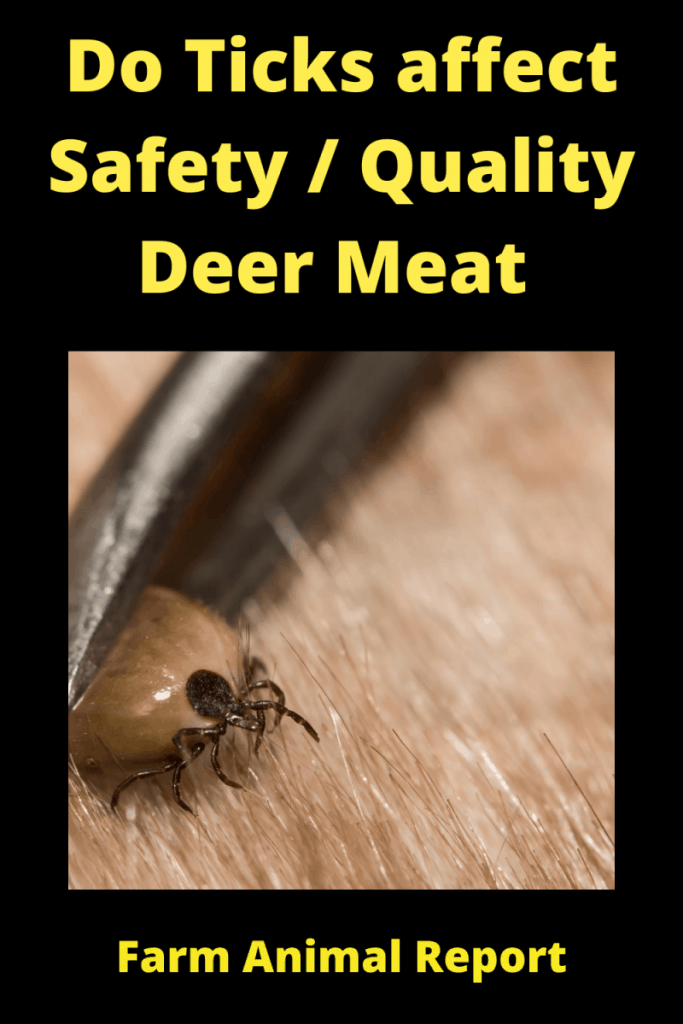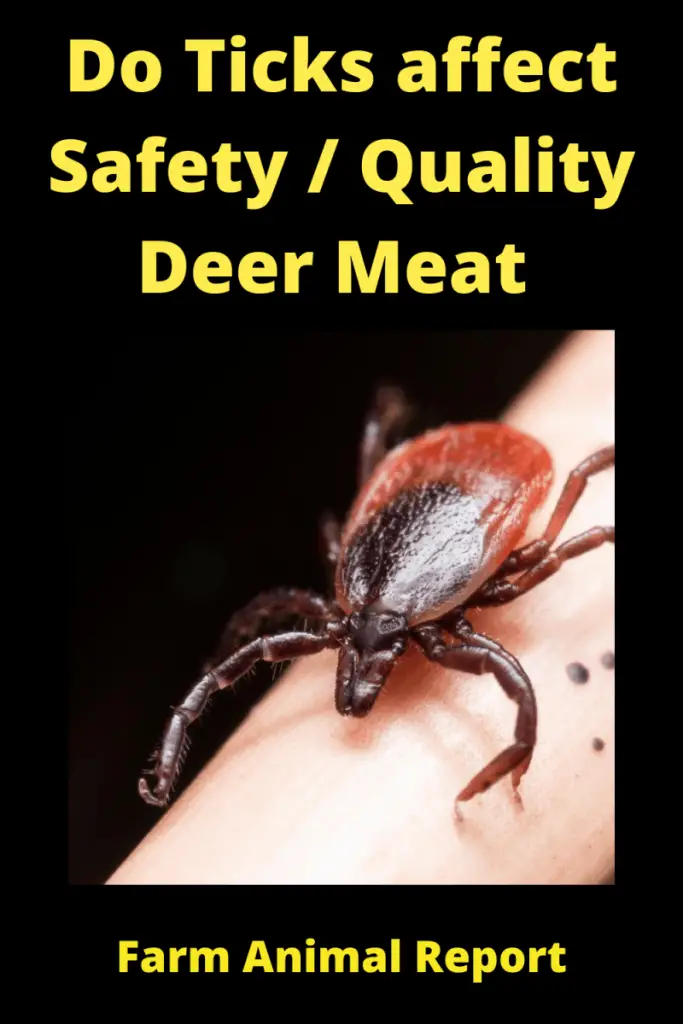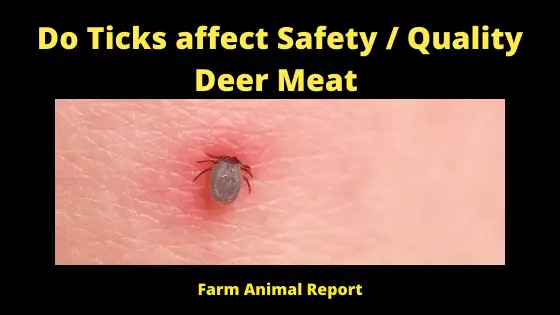How do Ticks affect Deer
As a General Rule, If Proper Cooking Methods are followed most bacteria that transmit disease from Deer to humans will be killed. Nothing will happen to you if you eat deer meat with Lyme disease. Here’s why: a tick carrying Lyme disease will only pass on the bacterium and will not survive long after the deer dies. Unless a human has an open wound, it is highly unlikely that Lyme disease will enter your body.
Deer Covered in Ticks- Safety of Deer Meat?
Deer Covered in Ticks – Do Ticks affect Deer Meat? If Proper Cooking Methods are followed most bacteria that transmit disease from Deer to humans will be killed. There are no know cases of transmission of Lyme disease by eating Deer Meat. There are concerns about Eating Deer wasting disease. See below
Check Out Amazons Educational Books on Whitetail Deer
A Deer Infected with an infected Tick can greatly affect the safety and quality of deer meat. The tick may transmit the disease. This disease is known as Lyme disease.
Before knowing this disease, you should know about the ticks which transmit this disease.
About Ticks:
Deer ticks (Ixodes scapularis) or black-legged ticks are the only ticks known to transmit Lyme disease. On the pacific coast, the ticks that transmit Lyme disease are the western black-legged tick (Ixodes pacificus). Dog ticks and other kinds of ticks are not known to cause Lyme disease.
The black-legged (deer) tick is a notorious bitting arachnid named for its dark legs. Blacklegged ticks are sometimes called deer ticks because their preferred adult host is the white-tailed deer. In the Midwest, black-legged ticks are called the bear tick.
Deer ticks are found primarily in the northeastern, mid-Atlantic, southeastern, and northcentral United States but extend into Mexico. The tick is of medical importance because of its ability to transmit Lyme disease, anaplasmosis, human babesiosis, Powassan encephalitis, and more.
The General Appearance of the Deer Tick:
When unengorged (i.e., not filled with blood), the female black-legged tick is roughly 1/8”, while male ticks are slightly smaller at about 1/6”. Both male and female deer ticks have flat, oval bodies, and are not hard-shelled.
Female deer ticks are orangish-brown in color except for their legs, mouthparts, and scutum (shield). Unengorged, their abdomen is a dark reddish-brown color but darker after feeding on a host. The male deer tick is reddish-brown overall.
The black-legged tick ( deer ticks ) is longer than wide, and its sharply pointed-toothed mouthparts are visible from above. Newly hatched unengorged larvae are about 1/32” long and have six legs. Unengorged nymphs are about 1/16” long and have eight legs.

Life Cycle and Feeding of the Deer Tick: (Weather)
Deer ticks live for about two years and go through four life phases: egg, larva, nymph, and adult. They feed exclusively on animal blood and eat only three-time during their lives:
- Once to molt from larvae to nymph
- Once from nymph to adult
- Once as adults to lay eggs.
They can contract the bacteria that causes Lyme disease from an infected host at any of these feedings but transmit it only during the second or third.
They must remain attached for at least 24 hours for the bacteria to transmit.
Larvae are minuscule, no bigger than the period at the end of this sentence, and feed only on birds or mice.
Nymphs are about as big as a poppy seed, but, like adults, will seek larger hosts, including deer, dogs, and humans. Adult females mate on or off a host and then feed for several days, swelling to twice their normal size. Once engorged, they drop off, lay their eggs amid the leaves, and die.
See Our Extensive Article – 7 Ways Deer Farmers Make Money
Lyme Disease:
Lyme disease is a tick-borne disease of humans and some domestic mammals caused by the bacteria Borrelia burgdorferi. Wild mammals and birds are often asymptomatic reservoirs for bacteria that rarely become ill.
The first case of Lyme disease in the United States was described in 1969 by a Wisconsin grouse hunter. The disease got its name after an outbreak occurred in 1975 in children from Lyme, Connecticut, but the bacteria responsible for causing it was not identified until 1982.
Clinical Signs:
Most wild mammals and birds do not seem to show clinical signs of Lyme disease. The one exception to this is the white-footed mouse. White-footed mice may temporarily exhibit reddening of the ear and neurological signs, including trembling, head tilt, circling to one side, loss of coordination, and weakness of the hind limbs.
Some domestic animals, especially dogs, develop clinical signs including fever, stiffness, lameness, and arthritis. Less commonly, domestic animals may experience kidney, neurological, eye, and cardiac problems.
The deer do not carry the bacteria. They are needed to continue the life cycle of the tick, but they are not infected. So as you killed deer, you would simply have more ticks per deer because the surface area of each is enough to support many ticks. Just killing deer won’t do the job.
Deer are immune to Lyme disease! It seems counterintuitive, as we correlate deer ticks to be the ultimate victor of the bacteria that cause Lyme disease. But it is true.
While deer help contributes to the deer tick population and transports those deer ticks to your property, they don’t spread Lyme disease to the ticks that bite them.
In fact, according to Columbia university eco-epidemiologist Maria Diuk, they have found that if a tick bites a deer, the tick becomes immune to the bacteria too and no longer spreads the disease. It sounds like there could be some research to find out if we can make humans immune to it too!

Deer Contribution to Tick Reproduction:
Deer contribute to the spread of Lyme in that they provide that last blood meal to the adults. Those ticks will lay thousands of eggs and boost the population of younger ticks, which will be out in the springs to spread Lyme. Ticks contract Lyme from the mice in which they receive their first blood meal.
In less frequent cases, a nymph deer tick will choose a deer as a host. The deer’s blood meal is when the nymph deer tick might be cleared of the Borrelia infection.
There are regular references to the fact that nymph ticks spread more Lyme than adults. This fact was mostly attributed to the fact that nymphs are smaller and less noticeable, and will have a great chance of staying embedded long enough to transmit the disease. But, as in all things Lyme disease-related, the situation is complex.
Can You Get Lyme Disease from Eating Deer Meat?
It is a known fact that some deer ticks carry Lyme disease, and if you are a hunter (or just an enthusiast of eating deer meat), you may be wondering what will happen to your body if you eat deer meat from an infected deer.
Nothing will happen to you if you eat deer meat with Lyme disease. Here’s why: a tick carrying Lyme disease will only pass on the bacterium will not survive long after the deer dies. Unless a human has an open wound, it is highly unlikely that Lyme disease will enter your body.
Cooking Infected Deer Meat Will also Kill any Bacteria.
That’s the good news, folk! Although it is unlikely that you will get Lyme disease by eating the infected deer meat, it is still possible to get Lyme if you have an attacked deer tick on your skin for up to 48 hours. This is why doorbusters strongly suggest installing a deer fence around your property and garden.
Per the National Center for Biological Information, a division of the National Institute of Health, the use of deer fencing has been proven to reduce the risk of Lyme disease by 83-97%. Without deer entering the area surrounding your home, new deer ticks become limited, and eventually, existing deer ticks become scarce.
Disease Precautions for Hunters: ( Blacklegged)
This paper is intended to be a general guide about diseases that hunters and their hunting dogs may encounter. Hunters should always consult their physician if they are concerned they have been exposed to a disease or are showing symptoms of illness.
If there are any concerns that your hunting dog or any other companion animal may have contracted any of these diseases, please contact the veterinarian.
There is an increasing awareness among hunters that there are medical risks associated with handling wildlife, and certain safety precautions should be taken. The American Veterinary Medical Association (AVMA) has the following advice for the hunter.
Hunters and their dogs can be exposed to infectious diseases not only from infected animals but also via insect vectors and contaminated soil and water.
Diseases transmitted from animals to humans, either through direct contact with the animal or a contaminated surface or water, through the ingestion of animal products, or insect transmission from an animal are called zoonotic diseases.
Protecting Hunters from Risk:
- Avoid hunting if you are feeling ill. People are more prone to disease if other illnesses or conditions weaken their immune systems.
- Take precautions to minimize insect bites.
- Do not handle or eat wild game or fowl that appeared ill or were acting abnormally before being killed.
- Do not eat, drink or smoke while cleaning wild fowl or game.
- Always protect your hands with gloves (heavy rubber, latex, or nitrile) when field dressing wild game or fowl.
- Do not use the same utensils to clean different species.
- If there are any old wounds on the carcass, and especially if there is pus present, meat in this area should be removed and discarded. A large area of tissue around the wound and pus pockets should also be cut away with the wound, even if the tissue looks normal because it can still harbor infection.
- If any abnormalities are seen in the carcass’s chest or abdominal cavity, consider disposing of the entire carcass.
- Minimize contact with the brain or spinal tissues. When boning out the carcass, keep both the head and spine intact. Do not cut into the head of an antlered animal that showed abnormal behavior, even to remove the rack. When removing antlers from a healthy animal, use a hand saw rather than a power saw, and always wear safety glasses.
- Avoid abdominal shots because they lead to contamination of the meat and can cause the animal needless suffering. If any intestinal contents of the game come into contact with meat, it should be considered contaminated and should be cut off and discarded. Do not feed the contaminated meat to other animals, or they may become infected.
- The big game should be the slot with a clean, humane kill shot, preferably avoiding the abdomen, followed quickly by removal of the intestines; this minimizes the risk of intestinal contents contaminating the meat.
- If any of the intestines have an abdominal smell or discharge, or if pockets of blood are seen in the muscle unassociated with the bullet/shot/arrow wound, the flesh should be considered unfit for eating.
- The abdominal cavity should be cleaned, dried, and cooled until the meat is processed. During warm weather, bags of ice should be placed in the body cavity to hasten to cool. The carcass should be protected against flies.
- Wash your hands thoroughly with soap and water or an alcohol-based sanitizer immediately after handling wild game or fowl, including the tissues and meat.
Guidelines for Avoiding the Deer Ticks:Deer Covered in Ticks (Blood)
Deer tick causes Lyme disease in the human while biting. For avoiding these deer ticks, there are some guidelines for hunters:
- Apply tick repellent to exposed skin and clothing. 20% DEET and picaridin are commonly used insect repellents. The CDC provides guidelines for selecting and using the appropriate insect repellent.
- If skin becomes wet from sweat or water, towel off and reapply to dry skin.
- Spray permethrin-containing products in outer clothing, including shoes. Permethrin is not an effective repellant for use on the skin. If chemical odors are a concern, there are unscented and neutral odor products available.
- Avoid wearing the same clothes on consecutive days without washing them first to remove ticks. Wash clothes immediately after returning home.
- Wear long-sleeved shirts and long pants.
- Conduct body checks immediately after returning from outdoor activities in tick-infested areas. Use mirrors if necessary, but check all body areas and remove all ticks found.
- Check children, especially behind the ears, back of the neck, around the waist, and in and along the hairline. Remove attached ticks by using fine-tipped tweezers. If tweezers are not readily available, you can improvise by shielding your fingers with tissue paper, a foil-covered gum wrapper, or a plastic sandwich bag and grasping the tick as close to the skin as possible, pulling upward with steady, even pressure.
Deer / Cervid Farming / Profitability Table
| Deer Type | Ave Weight | Average Calves/Yr | Gestation | Meat Retail Price/lb |
|---|---|---|---|---|
| White Tailed | 150 | 2 | 201 | $ 38.95 |
| Mule | 120 - 320 | 2 | 203 | $ 7 - 9.50 |
| Elk | 71- - 730 | 1 | 240 - 262 | $ 44.95 |
| Reindeer | 350 - 400 | 1 | 222 | $ 74.95 |
| Moose | 840 - 1500 | 1 | 243 | $ 7.50 |
| Sika | 93 | 1 | 224 | 34.95 |
| Red | 440 | 1 | 236 | $ 35.95 |
| Pere David's | 370 | 1 | 286 | |
| Axis | 79 | 2 | 227 | $ 29.99 |
| Mutjah | 30 | 1 | 214 | $ 39.95 |
Types of Deer for Deer Farming
| Breed of Deer | Weight | Price of Venison | ||
|---|---|---|---|---|
| Whitetail | Buck - 150 lb Doe - 100 lbs | $ 29.50 | ||
| Mule | Buck - 150 - 300 lbs Does - 95 - 200 lbs | $ 44.95 | ||
| Red | Buck 350 - 530 lbs Doe 260 - 370 lbs | $ 21.95 | ||
| Fallow | Buck - 130 - 200 lbs Does - 60 - 90lbs | $ 39.95 | ||
| Axis | Bucks 150 - 250 lbs Does 90 - 150 lbs | $ 43.95 | ||
| Reindeer | Buck 350 - 400 lbs Does - 180 - 260 lbs | $ 74.95 |





